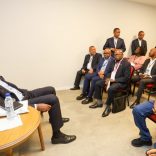Mozambique: Government launches tender for acquisition of 360 buses
Mozambique Ports & Railways: Companies owe CFM nearly US$ 60 million

Mozambique Railways is owed nearly US$ 60 million by companies that have used its cargo infrastructure and transportation services but have not paid up. If settled, this amount could contribute substantially to the financial strength of the company in charge of rail transport and port infrastructure.
The twenty-second meeting of directors of the company, which started yesterday in the city of Matola, Maputo province, provided an opportunity for the government to remind the company about the importance of strengthening debt collection mechanisms.
Minister of Transport and Communications Carlos Mesquita challenged directors to be “more efficient in collecting credits that reached close to US$60 million in 2017”, telling administrators and company directors that it was imperative that a thorough and serious effort was made with clients who were major debtors.
In fact, the government wants the CFM to set an example for other companies in the state’s business sector, which, according to the minister, are nothing more than “cost-generating centres”, O País reports. But this will not happen if “there is no improvement in economic and financial indicators related to debt collection in 2017”.
The minister offered some guidelines.
“There is an urgent need to indicate a person in charge and a deadline for the collection of these amounts. The Board of Directors must monitor compliance with this activity and regularly monitor this indicator so that the same situation does not recur, ” he said.
Volume of cargo transported increased in 2017
Even owed US$60 million, 2017 was a successful year for the Ports and Railways Company in Mozambique. In fiscal year 2017, the volume of cargo transported by the railway system, increased 22 percent, in addition to registering positive financial results.
“Our operating performance was positive, in that the rail system under CFM management transported about 11 million net tons against about 10 million net tons in 2016, representing a growth of 22 percent and 105 percent of target,” Chairman of the Board of Directors Miguel Matabele said.
Matabele added that, as a result of the iron and steel production generated in 2017, the general liquidity ratio increased from 1.35 in 2016 to 2.39, which means that the company was able to meet its short-term commitments.
In addition to analysing 2017 economic performance, the two-day meeting, which ends this Friday, will discuss plans for this year.












Leave a Reply
Be the First to Comment!
You must be logged in to post a comment.
You must be logged in to post a comment.